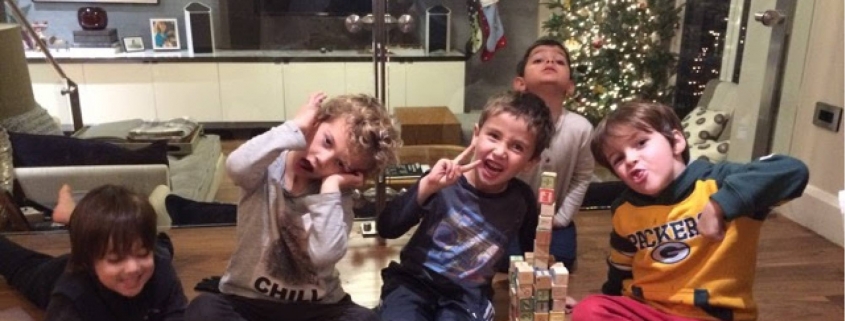How Different Cultures Celebrate December Holidays
When the ground freezes and the earth is covered in a blanket of snow, we tend to think of hibernation, rest, and quietude. Busy cultural calendars around the world stand in juxtaposition, as the colder months prove a time of feast and festivity. Learning about other traditions around the world is an interesting lesson in history, religion, and culture, but also an important opportunity to promote greater tolerance, acceptance, and celebration of diversity. Here are 10 different December holidays you may introduce to your child to provoke discussion and reflection of the winter season.
St. Nicholas Day (December 6, 2019)
St. Nicholas Day is celebrated in Eastern Christian religions — particularly in Russia and Greece, where Saint Nicholas is the patron saint. The Roman Empire bishop is known for generosity, kindness toward children, calming the seas, and performing miracles. The feast day is celebrated with children’s masses, special hymns, and prayer. In Western and Central European countries like Germany, Austria, Czechoslovakia, and the Netherlands — where children put out a boot for St. Nicholas on December 5th in hopes of receiving small coins, candy, oranges, toys, or glass ornaments in the morning. Historical recordings dating back to medieval times allege that nuns used the night of December 6th to distribute anonymous baskets of food and clothing at the doorsteps of the needy.
St. Lucia Day (December 13, 2019)
St. Lucia’s Day is celebrated in Sweden, Norway, and Swedish-speaking parts of Finland to honor the third-century virgin martyr. She is recognized as a symbol of light and purity, so the eldest daughter of the family dresses up in a long white gown with a red sash and wreath of burning candles on her head. She awakens the family by singing songs and bringing them coffee and twisted saffron buns called lussekatter (Lucia cats). Finland celebrates the day with a torchbearer parade of light. Norwegians hold processions through schools, hospitals, nursing homes, daycares, and senior centers to warm the heart and celebrate emergence out of the darkest winter nights.
Winter Solstice (December 21, 2019)
Winter Solstice has been celebrated for thousands of years by cultures all around the world. The shortest day of the year may have been observed as early as the Neolithic Period (the end of the Stone Age) in 10,200 BC. Archaeologists theorize monuments like Newgrange in Ireland, Maeshowe in Scotland, and Stonehenge in England were a place of December ritual. Today, there are large gatherings at these sites. Ancient Romans celebrated Saturnalia, a weeklong holiday of feasting and drinking in honor of Saturn, the god of agriculture. The Norsemen of Scandinavia celebrated Yule from the winter solstice through January, where they would feast until a large Yule log burned out. Zuni and Hopi Native American tribes commemorate the beginning of the new year with ceremonial mask dances, fires, and gift-giving. From hot yuzu fruit baths in Japan, to the “Burning of Clocks” in Brighton, England, Winter Solstice is celebrated in different ways around the world.
Hanukkah (December 22-30, 2019)
Jewish people around the world celebrate Hanukkah, a religious holiday honoring the Maccabee’s victory over King Antiochus, who forbade Jews from practicing their religion. During the re-dedication of the Second Temple in Jerusalem, the menorah’s candles were said to have miraculously burned for eight nights, even though there was only enough oil for a single day. Today, nine menorah candles are lit in the home for eight nights. During Hanukkah, blessings are said, special foods like potato pancakes (latkes) and jam-filled donuts (sufganiyot) are eaten, songs are sung, and children spin tops called dreidels to win nuts, raisins, and chocolate coins. Holidays like Passover and Rosh Hashanah are much more significant to the religion, but Hanukkah is special to many families as a cherished winter tradition nonetheless.
Christmas (December 25, 2019)
Christmas originated as a religious holiday celebrated by Christians around the world to commemorate the birth of Jesus Christ, the son of God. Religious celebrations involve candle-lit wreaths to represent the four weeks of Advent, songs like “O Come O Come Emmanuel,” readings of Christmas stories in the Bible, the display of Nativity Scenes, and December 24th Midnight mass in darkness to celebrate the birth of light. Over the years, Christmas has been adopted by non-Christian peoples as a secular holiday of gift-giving, decorating, caroling, storytelling, and feasting. Traditions vary around the world. Evergreen trees decorated with ornaments and lights date back to 16thCentury Germany. In Australia, where Christmas falls during summer, people head out to the beach and decorate a Christmas Bush. Depictions of Father Christmas or Santa Claus, based loosely on Saint Nicholas, go back at least as far as the reign of Henry VIII, where he appeared in plays wearing fur-lined green or red robes to deliver peace, joy, food, wine, and good cheer. Some say Santa arrives on Christmas Eve in a sleigh pulled by flying reindeer to deliver gifts to good girls and boys, but he arrives by boat in Hawaii and on water skis in Australia. Instead of leaving milk and cookies out for Santa Claus, children in England leave mince pies and brandy for Father Christmas. Iceland has thirteen Santas known as Yule Lads who leave small gifts for good children in shoes left on the window sill, and potatoes in the shoes of naughty children. From lantern festivals in the Philippines and Kentucky Fried Chicken dinners in Japan, to 42-foot-tall straw yule goats in Sweden and late night fireworks in Brazil, there is no shortage of ways to observe Christmas around the world.
Kwanzaa (December 26, 2019 – January 1, 2020)
Kwanzaa is a relatively young holiday created by Dr. Maulana Karenga in 1966 following the Watts riots in Los Angeles. He wanted to reconnect African Americans to African culture roots, borrowing traditions from Swahili “first fruit” harvest celebrations. Celebrations include song, dance, drumming, storytelling, poetry reading, and feasts. On each of the seven nights, a child lights a candle on the Kinara to represent the seven principle values of African culture: Unity, Self-Determination, Collective Work and Responsibility, Cooperative Economics, Purpose, Creativity, and Faith. Though it is celebrated mostly in America, more than 20 million people now celebrate the holiday from Jamaica, London, and South Africa, to Ghana, Toronto, and Paris — as seen in the documentary “The Black Candle.”
Boxing Day (December 26, 2019)
The observation of Boxing Day originated in the United Kingdom during the Middle Ages as a day where the church collection boxes for the poor were distributed to communities. Servants were given the day off to celebrate Christmas with their families. Boxing Day is now a public holiday in the UK, Canada, Australia, and New Zealand, where mail carriers and trade professionals enjoy a day of rest. For retail workers, Boxing Day is the busiest shopping day of the year, due to post-Christmas sales. In Ireland, they celebrate St. Stephen’s Day. In the Bahamas, the Junkanoo street parade and festival is held on Boxing Day. Not only is it a popular day of continued celebration and shopping, but also sport – with horse races, soccer matches, and ice hockey contests in European nations.
Ōmisoka (December 31, 2019)
Japan’s New Year’s Eve called Ōmisoka is considered one of the most important days of the year. Families visit shrines or temples at midnight for joya-no-kane, the striking of large cast bells for each of the 108 earthly desires that cause human suffering. Families gather to enjoy a feast of soba or udon noodles for one last time in the old year. Homes are cleaned and de-cluttered from top to bottom in osoji (the big cleaning). Many people also look forward to the national broadcast of the Red vs. White Singing Competition, which is akin to our “American Idol” competition.
Hogmanay (December 31, 2019)
During the Protestant Reformation, Christmas was banned in Scotland for some 400 years, so prior to 1958, the biggest winter holiday was Hogmanay, which started on December 31stand spilled over into the New Year. Families gathered for bonfires, large feasts, and the cleaning out of the fireplace. Many people still recognize the ancient tradition of “first-footing,” where it is believed the household is presented with good fortune when the first person to cross the threshold is a dark-haired male. (In those days, a red or blonde-haired stranger was probably an invading Norseman!) Different parts of Scotland have their own quaint Hogmanay traditions as well. For instance, Edinburgh is home to a huge street party and torchlight processions; balls of fire swing through the fishing village of Stonehaven; and fancy-dressed partiers swim in the icy waters of Firth of Forth at South Queensferry in what is called “the Loony Dook.”
New Year’s Eve (December 31, 2019)
“Out with the old and in with the new” is the idea behind the celebration of New Year’s Eve. Since New Year’s Day is a public holiday, the night before is spent feasting, partying, and ringing in the New Year at midnight. Most countries celebrate New Year’s Eve with fireworks – with the largest displays in New York’s Times Square; Rio de Janeiro, Brazil; Sydney, Australia; London, England; Edinburgh, Scotland; and Dubai, UAE. In Spain, 12 grapes are eaten at midnight to represent each month of the New Year. In Denmark, old plates and glasses are broken against the doors of friends and family to banish bad spirits. In Columbia, three “fortune-telling” potatoes are placed under the bed and pulled out at midnight – one peeled (financial problems), one unpeeled (abundance), and one half-peeled (something in between). In Ecuador, families symbolically burn a straw man at midnight in hopes that their faults with disappear with him. In Canada, New Year’s Eve is a popular ice-fishing day.
No matter what you’re celebrating this holiday season, you can find a place at Shine. We foster natural curiosity about cultures from around the world through crafts, storytelling, music, and culinary delights. Contact us to learn more about our wide range of inclusive workshops, classes, parties, and enrichment activities.



